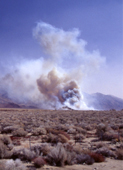
Wildfire danger
Increased productivity of invasive grasses and shrubs can increase the incidence of desert wildfires.
Climate Change
All other current ecological stressors must be considered in the context of climate change and its biological and ecological implications. Climate models show a slow warming of the Mojave and Sonoran Desert regions, especially at night.1 This warming is likely to alter rainfall and weather patterns, which could alter plant cover and productivity, and affect ecosystem functions, species distribution, and community composition.2,3 Desert ecosystems are particularly sensitive to changes in atmospheric carbon dioxide. Future rises in atmospheric carbon dioxide will affect rates of plant photosynthesis and water loss, and are predicted to increase efficiency and productivity in desert plants.4,5 Increased plant productivity, especially the productivity of invasive grasses, could increase the incidence of wildfire in the desert.6,7 Increased variability and more severe and persistent droughts are predicted for desert ecosystems worldwide.8 Therefore, climate change has implications for plants and their pollinators, wildlife species, and ecosystem processes, and may exacerbate effects from current stressors.
1 K.T. Redmond, “Historic Climate Variability in the Mojave Desert,” in The Mojave Desert: Ecosystem Processes and Sustainability, ed. R.H. Webb, L.F. Fenstermaker, J.S. Heaton, D.L. Hughson, E.V. McDonald, and D.M. Miller, (Reno: The University of Nevada Press, 2009), 11-30.
2 S.D. Smith, T.N. Charlet, L.F. Fenstermaker, and B.A. Newingham, “Effects of Global Change on Mojave Desert Ecosystems.” in The Mojave Desert: Ecosystem Processes and Sustainability, ed. R.H. Webb, L.F. Fenstermaker, J.S. Heaton, D.L. Hughson, E.V. McDonald, and D.M. Miller, (Reno: The University of Nevada Press, 2009), 31-56.
3 Intergovernmental Panel on Climate Change, “Deserts,” in Contribution of Working Group II to the Fourth Assessment Report of the Intergovernmental Panel on Climate Change, ed. M.L. Parry, O.F. Canziani, J.P. Palutikof, P.J. van der Linden, and C.E. Hanson, (Cambridge: Cambridge University Press, 2007), Section 4.4.2.
4 S.D. Smith, T.N. Charlet, L.F. Fenstermaker, and B.A. Newingham, “Effects of Global Change on Mojave Desert Ecosystems.” in The Mojave Desert: Ecosystem Processes and Sustainability, ed. R.H. Webb, L.F. Fenstermaker, J.S. Heaton, D.L. Hughson, E.V. McDonald, and D.M. Miller, (Reno: The University of Nevada Press, 2009), 31-56.
5 Intergovernmental Panel on Climate Change, “Deserts,” in Contribution of Working Group II to the Fourth Assessment Report of the Intergovernmental Panel on Climate Change, ed. M.L. Parry, O.F. Canziani, J.P. Palutikof, P.J. van der Linden, and C.E. Hanson, (Cambridge: Cambridge University Press, 2007), Section 4.4.2.
6 M.L. Brooks and J.R. Matchett, “Spatial and temporal patterns of wildfires in the Mojave Desert, 1980-2004,” Journal of Arid Environments 67 (2006): 148-164.
7 Intergovernmental Panel on Climate Change, “Deserts,” in Contribution of Working Group II to the Fourth Assessment Report of the Intergovernmental Panel on Climate Change, ed. M.L. Parry, O.F. Canziani, J.P. Palutikof, P.J. van der Linden, and C.E. Hanson, (Cambridge: Cambridge University Press, 2007), Section 4.4.2.
8 Intergovernmental Panel on Climate Change, “Deserts,” in Contribution of Working Group II to the Fourth Assessment Report of the Intergovernmental Panel on Climate Change, ed. M.L. Parry, O.F. Canziani, J.P. Palutikof, P.J. van der Linden, and C.E. Hanson, (Cambridge: Cambridge University Press, 2007), Section 4.4.2.
